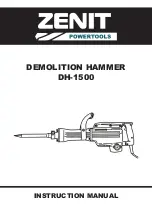
7
PROBLEM
POSSIBLE CAUSES
LIKELY SOLUTIONS
Tool will not start.
1. Cord not connected.
2. No power at outlet.
3. Tool’s thermal reset breaker tripped
(if equipped).
4, Internal damage or wear.
(Carbon brushes or Trigger, for
example.)
1. Check that cord is plugged in.
2. Check power at outlet. If outlet is unpowered,
turn off tool and check circuit breaker.
If breaker is tripped, make sure circuit is right
capacity for tool and circuit has no other loads.
3. Turn off tool and allow to cool.
Press reset button on tool.
4. Have technician service tool.
Tool operates slowly.
1. Forcing tool to work too fast.
2. Extension cord too long or cord
diameter too small.
1. Allow tool to work at its own rate.
2. Eliminate use of extension cord.
If an extension cord is needed, use one with the
proper diameter for its length and load.
See Extension Cords section.
Performance decreases
over time.
Carbon brushes worn or damaged.
Replace motor brushes.
See "REPLACING BRUSHES IN MOTOR"
in the Maintenance and Servicing section.
Excessive noise or rattling.
Internal damage or wear. (Carbon
brushes or bearings, for example.)
Have technician service tool.
Overheating.
1. Forcing tool to work too fast.
2. Blocked motor housing vents.
3. Motor being strained by long or small
diameter extension cord.
1. Allow tool to work at its own rate.
2. Wear ANSI-approved safety goggles and
NIOSH-approved dust mask/respirator while
blowing dust out of motor using compressed air.
3. Eliminate use of extension cord. If an extension
cord is needed, use one with the proper diameter
for its length and load. See Extension Cords
section.
Pipe doesn’t fit Die.
1. Die is inappropriate to pipe size.
2. Pipe inserted from wrong side.
3. Pipe not chamfered.
1. Choose a Die appropriate to the pipe.
2. Insert pipe from correct side.
See Workpiece and Work Area Set Up.
3. Make sure pipe end-to-be-threaded is chamfered.
Pipe spins.
Clamp is upside-down for the rotation
direction.
Move Clamp Bar to other side of Clamp.
Turn Clamp upside down and reclamp it to pipe.
See Workpiece and Work Area Set Up.
Dies break.
1. Die Blades insufficiently lubricated.
2. Die Blades installed in wrong order or
backwards.
1. Lubricate Die Blades sufficiently. See General
Operating Instructions section.
2. Ensure cutting edges of Blades face inward and
the number on each Die Blade is at the top and in
sequence. See Replacing Die Blades section.
Follow all safety precautions whenever diagnosing or servicing the tool.
Disconnect power supply before service.
7.3 Troubleshooting


























